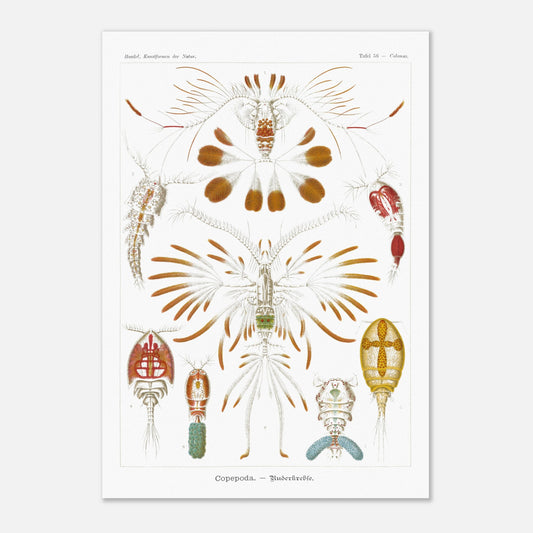Copepods - Illustrated drawing from life - Ernst Haeckel, Kunstformen der Natur
Copepods - Illustrated drawing from life - Ernst Haeckel, Kunstformen der Natur
Couldn't load pickup availability
Reproduction engraving of: Copepods
Original title Copepoda - Ruderkrabben
Calanus Poster - Arthropods of the class Crustacea or Crustacea (Order Copepoda)
Illustration from the book Kunstformen der Natur, which is a collection of artistic lithographs of natural sciences published by the German biologist Ernst Haeckel between 1899 and 1904.
This naturalistic illustration is part of an overall style inspired by Ernst Haeckel, which greatly influenced the emerging Art Nouveau movement at the beginning of the 20th century. This work, illustrating the impressive beauty and great diversity of the biological world, was complemented by a certain amount of scientific information, some excerpts of which are reproduced below.
This information is over 120 years old and some of it may be outdated!
Scientific classification:
Phylum of Arthropods (Articulata) Main class of Crustacea Shrimp Class (Caridonia) Order Copepoda.
Scientific notice (extract) accompanying the Copepoda poster print :
The order Ruderkrabben or Copepoda forms a large and very diverse group among the lower crustaceans (Entomostraca); more than a thousand species are now known. The great majority of them (more than nine-tenths) live in the sea, while only a small fraction inhabit fresh waters. About half of the species swim freely in the water and feed on small animals; the other half have increasingly adopted a parasitic life and spend a large part of their existence on fish and other aquatic animals; these parasites (the so-called "sea lice") show all stages of regression and degeneration. Most of the Copepoda are very small; they are only one or a few millimeters long; what they lack in size they make up for in enormous fecundity and rapid mass multiplication. Small Ruderkrabben are therefore a significant and frequent part of the plankton, that is, the mass of small animals and plants that float on the surface of the sea or at various depths without touching the bottom. Many species of free-swimming Copepoda appear in such large numbers that they color the water and form the main food of many larger aquatic animals, such as herring, mackerel, and other fish, as well as larger crustaceans, krakens, jellyfish, etc. Many Ruderkrabben are distinguished by the graceful shape of their appendages, the bright colors of their chitinous carapace, and their metallic luster. Their legs and caudal bristles are often feathered or adorned with fine, colored, feather-like appendages, which serve as flotation devices to prevent them from sinking in the water. Like insects on land, Ruderkrabben play an extremely important role in the water, adapting themselves in many ways to the most diverse living conditions; and like the former, they always retain, despite the greater diversity of their specific body forms, the same segmented character thanks to conservative heredity. In most free-living Copepoda, the segmented body consists of 15 segments or metameres, distributed evenly over the three main parts of the body; originally, five segments make up the anterior part, the head; five make up the central, widest part, the thorax; and five make up the posterior part, the abdomen or tail. The head (caput) bears two pairs of antennae and three pairs of jaws, one pair of mandibles (mandibulae), one pair of maxillae (maxillae), and one pair of postmaxillae (postmaxillae). Usually, the head is fused with the first thoracic segment and is therefore called the cephalothorax (cephalothorax). The five thoracic segments (thorax) each bear a pair of swimming legs, biramous and often feathery (Figures 1, 8). The five metameres of the abdomen (abdomen) bear no appendages; the last segment (telson) ends in a caudal fork, to which are attached long caudal setae. These may also be in the form of colorful feathers (Figures 1, 8). Females usually bear a pair of egg sacs at the base of the first abdominal segment (Figure 7). Males produce special sperm packets that they stick to the female. In general, males are smaller and more agile than females, which are more robust. All figures in this plate are greatly enlarged.
Species present on the Copepods - Calanus naturalist board :
- Calanus pavo
- Clytemnestra scutellata
- Oncaea venusta
- Cryptopontius thorelli
- Acontiophorus scutatus
- Corycaeus venustus
- Sapphirina darwinii
- Augaptilus filigerus
About this print
About this print
The layout and composition of this reproduction have been the subject of our greatest attention.
- Respect for the format of the original work: in order to faithfully transcribe the artist's intention, the work is not cropped/re-cut except in extreme cases (obvious imperfection, geometry problem, etc.) in which case the cropping will be as light as possible.
- The presence of white margins is sometimes necessary in order to present the work in a balanced manner.
- Each size offered has been specifically composed, therefore, the size of the white margins may vary from one print size to another. Remember to check this detail carefully!
- Print only, frame not included!
Features
Features
- Premium 200gsm matte white paper, durable and strong.
- Natural, smooth uncoated finish, silky to the touch
- FSC certified paper or equivalent certifications depending on regional availability.
- Each print is shipped in sturdy packaging, ensuring safe transport.
- Each print is printed and shipped on demand. No minimum order quantity is required.
Share !









Recently viewed products
We are listening to you
If you are looking for a specific composition, a particular layout, or any other customization need, our team is at your disposal and will do everything possible to meet your requests.
So don't hesitate to...




